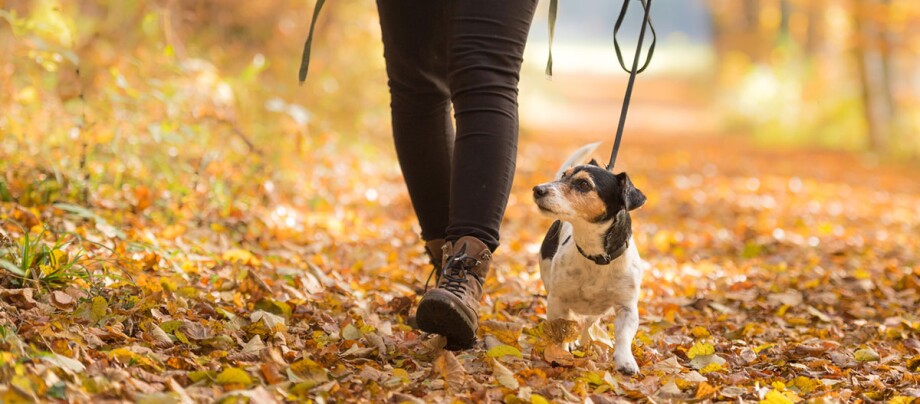Leash Training – Understanding Your Dog for Stress-Free Walkies
07.10.2022 - Reading time: 5 minutes

Panting, pulling, yelping - unfortunately, many dogs cannot walk calmly on a leash. The problem: they haven't learned any better and neither have their owners. Yet every dog owner dreams of a relaxed walk with their four-legged friend, with the leash hanging loosely in their hand. Read in this guidebook why most dogs react differently on a leash than off it and how you can train your dog to walk on a leash.
Understanding your dog: Why dogs pull at the leash.
Have you ever asked yourself what your dog thinks about when he goes for a walk? A walk from the perspective of your dog is not to be able to go to the loo as quickly as possible and then to dash back to the sofa. For your dog, going for a walk is a bit like reading the newspaper for us, in other words, sniffing out the markings from his peers and also meeting them as an equal. If you drag your dog away from these sources of information, you are denying him both a fascinating activity and also the expression of an innate behavioural pattern. As time goes on, your dog will come to associate going for a walk with something negative and will see you and the leash as obstacles. Obedience training therefore means making yourself actively interesting for your dog once again and taking over the leadership role, because dogs are excellent observers. They know when you are feeling stressed and not paying attention, which can end up with your dog wanting to take over your leadership role (and sometimes actually achieving this).
Correct your attitude: Lead, do not dominate
It is true that a dog’s permanent pulling at the leash is a huge stress factor for its owners, in particular if it is a powerful dog with a lot of weight behind it. However, the situation just gets worse if you start to take out your sense of frustration on your dog. It’s worth taking some time out to consider what going for a walk could actually mean for you and your dog in order to break the vicious circle.
What walking your dog means for you:
- Reducing stress
- Exercise in the fresh air
- A break from the daily routine
- Social interaction with other dog owners and neighbours
Meaning of going for a walk for your dog:
- Satisfying your natural urge for movement
- Getting rid of stress
- Social interaction
- “Reading the newspaper” as a socially necessary behaviour
- Exciting time with my owner
Obedience training
It’s always difficult at the beginning, particularly if bad habits have already become the norm for when you go on a walk. Here are a few tips on how you can approach obedience training with your dog:
Tip 1: Right frame of mind:
Try to be relaxed when you take your dog for a walk. The walk should be a pleasure for both you and your dog. Give your dog your full attention.
Tip 2: Right environment:
Obedience training is best done in a peaceful setting with few distractions. To begin with, this can be your living room, where your dog learns to pay more attention to you and to obey the command “Heel”.
Tip 3: Right time of day:
Give your dog time to do his business before you start on training. You can introduce the training element at home with search and alertness games. Once you are outdoors, you must get your dog’s attention even more fixed on you, by, for example, taking his favourite toy
Tip 4: Dogs love excitement:
Make your walk as exciting as possible. The aim is to get your dog completely focused on you. Now and again try hiding his favourite toy and let him try to find it. Squeak with a squeaky toy and call his name at the same time or give the command “Look here”. You can reinforce these exercises with a clicker.
Tip 5: Obedience work with treats:
Make walking on the leash a positive experience, by practising walking at heel with treats. For positive reinforcement, try a short period of being on the leash at home whilst you stroke him or play with him.
Tip 6: Meet stubbornness in your dog with perseverance:
Your dog tells you where to go when you go for a walk? Don’t allow that. Let your stubborn little pet wait with a slack lead. Don’t look at him, but look in the direction you want to go. Call your dog to you. If he looks at you or starts moving in your direction, reinforce this positive behaviour with lavish praise and finally a treat. Repeat this exercise as often as necessary and never lose your patience. Use the same exercise if you have a dog that is pulling at the lead. Abruptly change direction and then continue.
What you should never do
Don’t get frustrated if the training doesn’t work immediately, but keep working at establishing a good relationship with your dog. Use rewards, motivation and your own knowledge, as well as the advice from experts. Pay attention to your dog’s body language as well, as that can tell you when he is feeling overtaxed, tired, anxious or stressed.
Say no categorically to all measures that could be a torment for your dog. Choke chains, spiked collars, spray collars and collars emitting stimulation currents are prohibited in Germany, Austria and Switzerland.
You should pay attention to this in obedience training:
- Hitting your dog or shouting at him are not only counterproductive for obedience work, but can also permanently unsettle your dog and make him ill.
- So-called halti headcollars should only be used by experienced dog handlers. They can result in permanent postural defects in your dog.
- Instead of using a collar you can use a harness, which relieves the pressure on your dog’s sensitive neck.
If you experience serious problems with your dog’s behaviour, consult a vet whose advice you trust or look for a specialist dog school.


